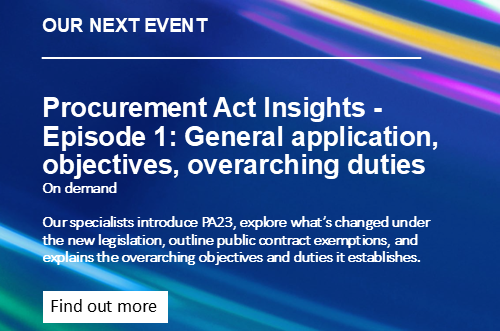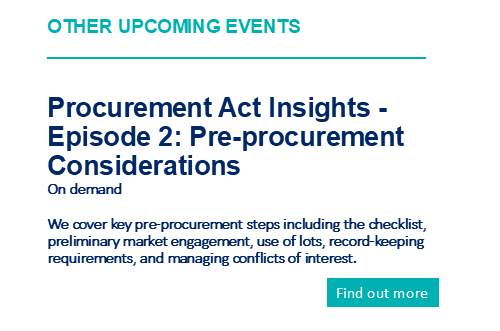- Details
Subsidy Control Act 2022 in force
![]() Steve Gummer, Saira Ahmed and Oliver Slater consider the Subsidy Control Act 2022, which came into force this week (4 January 2023). The Act sets out the UK’s prevailing subsidy control rules. Public authorities should consult the Act when contemplating the award of subsidies.
Steve Gummer, Saira Ahmed and Oliver Slater consider the Subsidy Control Act 2022, which came into force this week (4 January 2023). The Act sets out the UK’s prevailing subsidy control rules. Public authorities should consult the Act when contemplating the award of subsidies.
Background
Since EU State aid rules ceased to apply to UK authorities on 1 January 2021, public bodies across the UK have been required to comply with an interim subsidy control regime, primarily set out in the UK Trade & Cooperation Agreement (the “TCA”). The Subsidy Control Act 2022 (the “Act”) replaces the interim regime and sets out the framework under which public authorities should award subsidies going forward.
Overview
The Act sets out a four-step process for public authorities to follow when contemplating the award of public funds:
1. Is it a subsidy?
If proposed state support fails to satisfy the statutory definition of a “subsidy”, authorities need not consider the subsidy control regime further. The four-limbed definition is set out in section 2 of the Act. Note that all four limbs must be satisfied for the proposed support to qualify as a subsidy.
Not all public contracts will qualify as subsidies. By way of example, the Statutory Guidance notes that purchasing goods and services at market rate may not satisfy the test.
2. If it is a subsidy, is the subsidy automatically unlawful?
The Act prohibits certain categories of subsidies. If the proposed support falls within one such category, it is automatically unlawful. There are no workarounds or defences to the following categories of subsidies:
- unlimited state guarantees;
- subsidies contingent upon export performance relating to goods or services;
- subsidies contingent on the use of domestically produced goods or services;
- subsidies requiring relocation of all or part of a beneficiary’s existing economic activities where such relocation would not occur in the absence of the subsidy; and
- subsidies granted to rescue an ailing or insolvent enterprise, unless certain conditions are met.
3. If the subsidy is not rendered automatically unlawful, do any exemptions apply, or is the subsidy awarded under a scheme or streamlined route?
The Act includes several exemptions from the requirement to comply with the relevant subsidy control principles (set out below):
- where the subsidy only represents de minimis financial assistance (i.e. assistance below £315,000 over any three-year period);
- for subsidies for natural disasters and other exceptional circumstances and emergencies;
- for subsidies to safeguard national security;
- for subsidies given by the Bank of England in pursuit of monetary policy;
- for subsidies given pursuant to certain financial stability directions issued by the Treasury;
- for subsidies which are tax measures otherwise permitted under the TCA; and
- for subsidies given in the context of a large cross-border or international cooperation project.
If awarded under a subsidy scheme, individual subsidies do not need to be assessed against the principles (set out below). The government has also published three streamlined routes in draft. Once finalised, the streamlined routes will operate similarly to the EU General Block Exemptions: compliance with the routes means authorities will not be required to consider the subsidy control principles. The draft streamlined routes relate to research, development and innovation; energy usage; and local growth.
4. Does the subsidy comply with the subsidy control principles?
If there is no applicable exemption, public authorities must carry out an assessment involving analysis against each of the seven subsidy control principles:
- Subsidy pursues a specific policy objective to remedy an identified market failure, or to address an equity rationale such as social difficulties or distributional concerns.
- Subsidy is proportionate and limited to what is necessary to achieve the objective.
- Subsidy is designed to bring about a change of economic behaviour of the beneficiary that is conducive to achieving the objective and that would not happen without the subsidy.
- Subsidy should not normally compensate for the costs the beneficiary would have funded in the absence of any subsidy.
- Subsidy is an appropriate policy instrument to achieve its objective and that objective cannot be achieved through other less distortive means.
- Subsidy is designed to achieve its objective while minimising any negative effects on competition or investment within the United Kingdom.
- The subsidy’s beneficial effects to achieving the objective outweigh any negative effects, including in particular the negative effects on competition or investment within the United Kingdom and international trade or investment.
Additional requirements
Public authorities should also note that additional requirements apply to the following categories of subsidies:
- subsidies given for Services of Public Economic Interest (“SPEI”) to SPEI enterprises – these are essential public services against which additional requirements are imposed (see section 29); and
- subsidies and schemes in relation to energy or the environment must be assessed against the relevant principles set out in Schedule 2 of the Act, as well as the seven subsidy control principles.
Referral to the Subsidy Advice Unit and the BEIS subsidy database
The Act sets out a new mechanism for mandatory and discretionary referral of certain subsidies to the Competition and Markets Authority (the “CMA”).
Subsidies of particular interest must be referred to the new Subsidy Advice Unit (the “SAU”) at the CMA before award. A subsidy is of particular interest if both of the following criteria apply:
- the subsidy exceeds £1m; and
- the total amount of the subsidy and any other related subsidy given to the same enterprise within the last three financial years exceeds £10m.
A subsidy is therefore categorically of particular interest if it exceeds £10m.
Subsidies of interest may also be referred to the SAU (at the discretion of the awarding authority). Subsidies of interest are other subsidies of between £5-10m which do not qualify as subsidies of particular interest.
The SAU will publish a report analysing the extent to which referred subsidies comply with the subsidy control requirements set out above. The report is not binding on the referring authority but will be made publicly available on the CMA’s website. In the case of mandatory referrals, the SAU has five working days to confirm whether or not the referral complies with the necessary requirements, The SAU then has 30 working days in which to publish its report (such time can be extended by agreement with the referring authority or as directed by the Secretary of State). Following publication, there is a five-working day “cooling off period” in which the subsidy cannot be awarded.
The SAU’s own guidance provides for a voluntary pre-referral consultation process.
Authorities should also note that transparency rules require details of subsidies and schemes to be uploaded to the BEIS subsidy database. The database is publicly accessible.
The importance of compliance
Non-compliance with the Act raises the risk of potential challenge in the UK Competition Appeal Tribunal (the “CAT”). The CAT will review any subsidy referred to it on public law grounds.
Our expert team is already advising private bodies and public authorities on their obligations pursuant to the Act. The team is available to assist with all aspects of the new regime, including analysis of compliance with the principles and referral to the SAU.
Steve Gummer is a Partner, Saira Ahmed is an Associate and Oliver Slater is a Trainee Solicitor at Sharpe Pritchard LLP.
For further insight and resources on local government legal issues from Sharpe Pritchard, please visit the SharpeEdge page by clicking on the banner below.
This article is for general awareness only and does not constitute legal or professional advice. The law may have changed since this page was first published. If you would like further advice and assistance in relation to any issue raised in this article, please contact us by telephone or email
|
Click here to view our archived articles or search below.
|
|
ABOUT SHARPE PRITCHARD
We are a national firm of public law specialists, serving local authorities, other public sector organisations and registered social landlords, as well as commercial clients and the third sector. Our team advises on a wide range of public law matters, spanning electoral law, procurement, construction, infrastructure, data protection and information law, planning and dispute resolution, to name a few key specialisms. All public sector organisations have a route to instruct us through the various frameworks we are appointed to. To find out more about our services, please click here.
|
|
OUR RECENT ARTICLES
December 10, 2025
Sharpe Pritchard appointed to £60m London Boroughs’ Legal Alliance frameworkSharpe Pritchard, one of the UK’s leading public law firms, has been re-appointed to the London Boroughs’ Legal Alliance (LBLA) Solicitors Panel.
November 20, 2025
Strengthening the standards and conduct framework for local authorities in EnglandJames Berry offers his insight into how the proposed changes to standards and conduct rules will affect local authorities.
November 04, 2025
Procuring and operating open frameworks under the Procurement Act 2023Chantelle Pink offers advice to authorities on open frameworks and how to procure them.
October 31, 2025
Building Solar – 5 Top Tips for Solar Farm Construction ContractsSolar farm construction contracts are in focus following fascinating insights into the continuing global uptake and expansion of renewables, and particularly solar, within the 2025 mid-year report of Ember, a global energy think tank.
|
|
OUR KEY LOCAL GOVERNMENT CONTACTS
|
||
|
Partner 020 7406 4600 Find out more |
||
|
Partner 020 7406 4600 Find out more |
||
|
Rachel Murray-Smith Partner 020 7406 4600 Find out more |







 Catherine Newman
Catherine Newman
